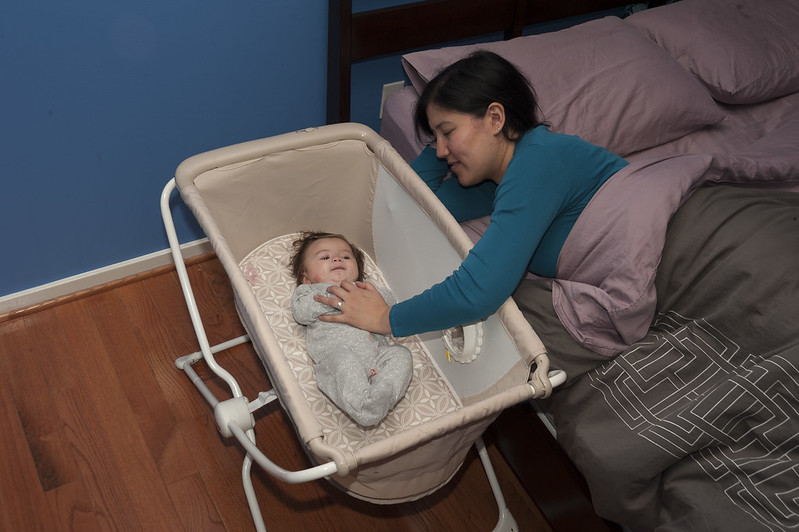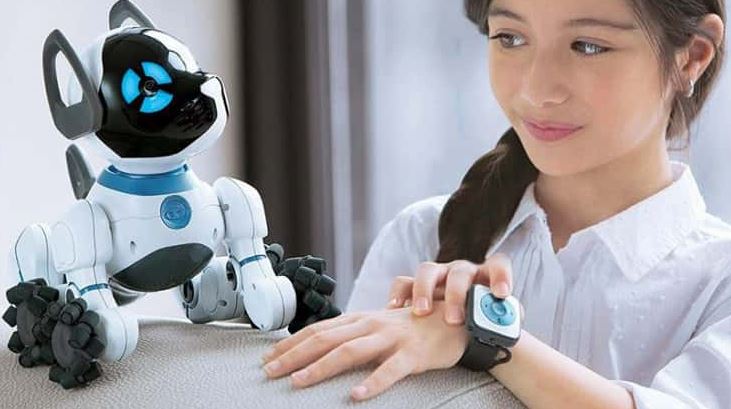It is a much more difficult task to transition your baby from a bassinet into a regular crib than most parents realize. This is important for your child’s safety as well as their future sleep.

Your child should be four months old to move. This is when your child’s gross motor skills take a big leap (such as rolling on their stomach or sideways) and it is also the time they start to roll over. There are new safety concerns when a baby is mobile. We don’t want them to wait for something to go wrong before we take action to protect them. We now protect them from harming ourselves, and we must not wait for something to happen before we take action. This is a good practice for the teenage years.
Sidewalls on a bassinet or cosleeper are not high enough to protect the baby’s head from falling out if they pull or push themselves too high to reach the top of the sidewall. Because their heads weigh so much more than the rest of the body, they can push themselves over the edge. Because babies are more likely to learn, obsess about, and practice exciting new skills in their sleeping environment, which also has less supervision, it should be the safest in your home.
WHEN IS BASSINET TOO BIG?
Bassinets and bedside sleeping systems are great for newborns but they only last for a limited time. Most have a weight limit, which can be anywhere from 10 to 20 pounds.
Although most bassinets don’t have a maximum height, it is important to ensure your baby doesn’t feel too restricted. When you lay your baby down, do they touch the edges? It could be time for your baby to move from the bassinet to a crib.
WHEN TO STOP USING BASSINET?
Your baby’s age is one sign that it is time for you to move from a bassinet to a crib. However, there are many other indicators to consider when you decide to stop using a bassinet. Your baby’s mobility is another important indicator. A bassinet that is too mobile for an infant can be dangerous.
It is a great reason to celebrate milestones such as pulling up and rolling over. If your baby is rolling in a bassinet, it’s time to move to the crib. Bassinets have a lower profile than cribs. A crib has the option to lower the mattress. However, this is not always possible with a bassinet. To keep your baby safe, a baby that rolls in a bassinet is a sign it’s time for you to inspect the crib.
AT WHAT AGE SHOULD A BABY STOP SLEEPING IN A BASSINET?
At four months of age, a massive cognitive brain surge occurs and object permanence is formed. Babies become more aware and attached to their environment by the age of five to six months. They thrive on familiarity and consistency.
This is why
At four months, the baby can transition to a safer crib or a more permanent sleeping environment.
Related: How To Get Newborn To Sleep In A Bassinet
HOW TO TRANSITION BABY TO CRIB?
You have many options to help your baby transition from a bassinet to a crib. This will not be a big deal for some children. It will take some time and be a slow process for others. To make things more smooth, you will need to be ready for hiccups.
These are some tips to help a baby transition from a bassinet into a crib:
* Develop a bedtime routine. You could use this time to cuddle, read, and take a bath. Your baby will respond well to routines and you can start to signal that it is time for bed. To help your baby associate sleep with the nursery, you should also do the nursery’s bedtime routine before he or she moves to a crib.
* Comfortable bedding is essential for the baby’s first year. This includes a mattress that is firm and fitted with a sheet. No blankets, toys, or loose sheets. Comfort items cannot be placed in the crib to ensure safety. However, this doesn’t mean that you shouldn’t make every effort to make your baby’s nursery comfortable. You can dim the lights, or play white noise.
* Make the transition slowly. It can be difficult to go from a cosleeper into a crib. You can make the transition easier by letting your child sleep in the crib during nap time and nighttime. After they are comfortable with sleeping in the crib, you can introduce the second sleep time.
You can temporarily move the crib into your bedroom. Some babies don’t like two large changes at once. It might be easier to make one change at a given time if this is the case. You might consider putting the crib in your bedroom for a few nights if you have enough space.
* Stay temporarily in the baby’s bedroom. You can make the transition easier by staying in the nursery with them for the first few nights. This does not mean that you have to get into the crib. That would be against many crib weight limits and put everyone at risk. We recommend that you sleep on a couch, bed, or air mattress.
* Use Swaddle for better sleep. Many babies find the crib too big. A swaddle, can make them feel cozy and snug in their new bed. You should also transition your baby from the swaddle to a crib if they’re starting to roll over.
While room-sharing is an important time for parents and their babies, it can also be a great way to transition to the next stage of your life. It may take some adjustment to transition your baby from the bassinet into a crib. This is a necessary change, but it’s best for your family.
Your baby can transition slowly by placing them in their safe, new crib for a few naps per day and then to all naps until they fall asleep at night.
Safe and sound babies are the best for everyone.



